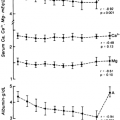DIAGNOSTIC IMAGING OF THE SELLAR REGION
Eric Bourekas
Mary Oehler
Donald Chakeres
Radiographic imaging of the sella and hypothalamic region is important in the overall evaluation of many patients with endocrine and metabolic disorders. Often, imaging is crucial, because different pathology in this region may present with similar clinical findings. Imaging can help identify a number of diagnostic entities based on anatomicopathologic characteristics. For example, in patients with hypopituitarism, one can often pinpoint the etiology more precisely, determining, for example, whether it is secondary to congenital absence of the gland, septo-optic dysplasia, transection of the pituitary stalk, a large pituitary mass, a suprasellar arachnoid cyst, a hypothalamic glioma, or an eosinophilic granuloma. In addition, in those patients who have known endocrine disorders such as acromegaly, imaging characterizes other important anatomic aspects of the pathology, such as the size of the mass and possible involvement of the optic chiasm or cavernous sinuses. Imaging of the venous drainage of the pituitary fossa is also used to allow for venous sinus sampling of blood for hormone analysis. Finally, imaging helps direct interventional procedures (i.e., surgery, radiotherapy) in the sellar region and plays a role in postoperative evaluation.
In this chapter, the various imaging modalities and their advantages and disadvantages are discussed in terms of their specific applications. A review is provided of the normal imaging anatomy and of the more commonly encountered pathologic entities, including normal variations, congenital anomalies, inflammations, neoplasms, trauma, and vascular disorders. The focus is primarily on disorders associated with endocrine malfunction.
Stay updated, free articles. Join our Telegram channel

Full access? Get Clinical Tree





